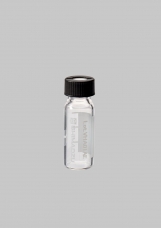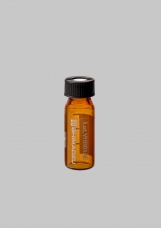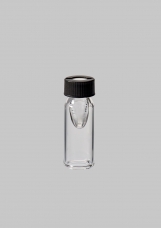Shim-vial
Shim-vial™ H glass, S glass
Vials are extensively used in an analysis. Accordingly, they are likely to be chosen with a focus on cost. However, if problems with cracks or contamination occur, this can interfere with the analysis or have an impact on data reliability. Shimadzu provides high-quality vials that thoroughly eliminate these risks by visually inspecting each vial, allowing them to be used with confidence.
Features:
Proprietary Cleaning Treatment Suppresses Sample Adsorption by the Vials
Are your peaks sometimes unstable or smaller than expected? Depending on the vial, it is possible that the sample is being adsorbed by the inner surface of the glass, which can reduce the recovery ratio. Shim-vials H and S are made from medical grade borosilicate glass, certified as Type 1 glass in the U.S. Pharmacopoeia (USP), and sample adsorption is suppressed by the application of a proprietary cleaning treatment. An additional cleaning process is applied to the Shim-vial H glass to suppress adsorption to the utmost. Accordingly, these are the optimum vials for LC-MS when performing trace-quantity analysis. Using these revolutionary vials enables more accurate and stable analysis results.
We Place Importance on Both Containers and Quality
These vials are manufactured in the same facilities as pharmaceutical packaging materials, and are delivered to the customer only after passing a strict shipment inspection. The vials, caps, and septum are managed by lot, and they come with a traceable quality certificate. Low background levels and low adsorption, which are important in LC and LC-MS analysis, are tested for by lot, so you can use these vials with confidence.
Vial Selection by Application
Our lineup includes Shim-vial H, which enables trace-quantity analysis of basic compounds prone to adsorption by glass, thanks to advanced low adsorption treatment, and the cost-effective Shim-vial S.
And our small-volume vials with their unique shape are made of the same materials and receive the same cleaning treatment as the 1.5 mL vials. They suppress adsorption more than other small-volume inserts by limiting the contact surface between the sample and the container.
Product Catalog: Download PDF
Application Note: Download Application Note
Product Listing
-
Description:
For high-sensitivity analysis ppt order high-sensitivity analysis (LC–MS) Analysis of compounds prone to adsorption (LC–MS and LC) Analysis with a focus on repeatability (QA/QC) Analysis requiring a low background
OUT OF STOCKFor high-sensitivity analysis ppt order high-sensitivity analysis (LC–MS) Analysis of compounds prone to adsorption (LC–MS and LC) Analysis with a focus on repeatability (QA/QC) Analysis requiring a low background
-
Description:
For high-sensitivity analysis ppt order high-sensitivity analysis (LC–MS) Analysis of compounds prone to adsorption (LC–MS and LC) Analysis with a focus on repeatability (QA/QC) Analysis requiring a low background
OUT OF STOCKFor high-sensitivity analysis ppt order high-sensitivity analysis (LC–MS) Analysis of compounds prone to adsorption (LC–MS and LC) Analysis with a focus on repeatability (QA/QC) Analysis requiring a low background
-
Description:
For high-sensitivity analysis ppt order high-sensitivity analysis (LC–MS) Analysis of compounds prone to adsorption (LC–MS and LC) Analysis with a focus on repeatability (QA/QC) Analysis requiring a low background
OUT OF STOCKFor high-sensitivity analysis ppt order high-sensitivity analysis (LC–MS) Analysis of compounds prone to adsorption (LC–MS and LC) Analysis with a focus on repeatability (QA/QC) Analysis requiring a low background
-
Description:
For high-sensitivity analysis ppt order high-sensitivity analysis (LC–MS) Analysis of compounds prone to adsorption (LC–MS and LC) Analysis with a focus on repeatability (QA/QC) Analysis requiring a low background
OUT OF STOCKFor high-sensitivity analysis ppt order high-sensitivity analysis (LC–MS) Analysis of compounds prone to adsorption (LC–MS and LC) Analysis with a focus on repeatability (QA/QC) Analysis requiring a low background
-
Description:
Our small-volume vials with their unique shape are made of the same materials and receive the same cleaning treatment as the 1.5 mL vials. They suppress adsorption more than other small-volume inserts by limiting the contact surface between the sample and the container. In addition, the bottom surface of the vial is hollowed out in order to increase thermal conductivity. Residual volume: Approx. 10 μL When using it, adjust the needle stroke parameter to be 15 mm higher than for the 1.5 mL vials. For example; Shimadzu SIL-40 series: 32 mm or less
OUT OF STOCKOur small-volume vials with their unique shape are made of the same materials and receive the same cleaning treatment as the 1.5 mL vials. They suppress adsorption more than other small-volume inserts by limiting the contact surface between the sample and the container. In addition, the bottom surface of the vial is hollowed out in order to increase thermal conductivity. Residual volume: Approx. 10 μL When using it, adjust the needle stroke parameter to be 15 mm higher than for the 1.5 mL vials. For example; Shimadzu SIL-40 series: 32 mm or less
-
Description:
Our small-volume vials with their unique shape are made of the same materials and receive the same cleaning treatment as the 1.5 mL vials. They suppress adsorption more than other small-volume inserts by limiting the contact surface between the sample and the container. In addition, the bottom surface of the vial is hollowed out in order to increase thermal conductivity. Residual volume: Approx. 10 μL When using it, adjust the needle stroke parameter to be 15 mm higher than for the 1.5 mL vials. For example; Shimadzu SIL-40 series: 32 mm or less
OUT OF STOCKOur small-volume vials with their unique shape are made of the same materials and receive the same cleaning treatment as the 1.5 mL vials. They suppress adsorption more than other small-volume inserts by limiting the contact surface between the sample and the container. In addition, the bottom surface of the vial is hollowed out in order to increase thermal conductivity. Residual volume: Approx. 10 μL When using it, adjust the needle stroke parameter to be 15 mm higher than for the 1.5 mL vials. For example; Shimadzu SIL-40 series: 32 mm or less
-
Description:
Our small-volume vials with their unique shape are made of the same materials and receive the same cleaning treatment as the 1.5 mL vials. They suppress adsorption more than other small-volume inserts by limiting the contact surface between the sample and the container. In addition, the bottom surface of the vial is hollowed out in order to increase thermal conductivity. Residual volume: Approx. 10 μL When using it, adjust the needle stroke parameter to be 15 mm higher than for the 1.5 mL vials. For example; Shimadzu SIL-40 series: 32 mm or less
OUT OF STOCKOur small-volume vials with their unique shape are made of the same materials and receive the same cleaning treatment as the 1.5 mL vials. They suppress adsorption more than other small-volume inserts by limiting the contact surface between the sample and the container. In addition, the bottom surface of the vial is hollowed out in order to increase thermal conductivity. Residual volume: Approx. 10 μL When using it, adjust the needle stroke parameter to be 15 mm higher than for the 1.5 mL vials. For example; Shimadzu SIL-40 series: 32 mm or less
-
Description:
Our small-volume vials with their unique shape are made of the same materials and receive the same cleaning treatment as the 1.5 mL vials. They suppress adsorption more than other small-volume inserts by limiting the contact surface between the sample and the container. In addition, the bottom surface of the vial is hollowed out in order to increase thermal conductivity. Residual volume: Approx. 10 μL When using it, adjust the needle stroke parameter to be 15 mm higher than for the 1.5 mL vials. For example; Shimadzu SIL-40 series: 32 mm or less
OUT OF STOCKOur small-volume vials with their unique shape are made of the same materials and receive the same cleaning treatment as the 1.5 mL vials. They suppress adsorption more than other small-volume inserts by limiting the contact surface between the sample and the container. In addition, the bottom surface of the vial is hollowed out in order to increase thermal conductivity. Residual volume: Approx. 10 μL When using it, adjust the needle stroke parameter to be 15 mm higher than for the 1.5 mL vials. For example; Shimadzu SIL-40 series: 32 mm or less
-
Description:
For routine analysis Analysis of general compounds (LC–MS and LC) ppm to ppb order high-sensitivity analysis Analysis with a focus on repeatability (QA/QC) Analysis requiring a low background
OUT OF STOCKFor routine analysis Analysis of general compounds (LC–MS and LC) ppm to ppb order high-sensitivity analysis Analysis with a focus on repeatability (QA/QC) Analysis requiring a low background
-
Description:
For routine analysis Analysis of general compounds (LC–MS and LC) ppm to ppb order high-sensitivity analysis Analysis with a focus on repeatability (QA/QC) Analysis requiring a low background
OUT OF STOCKFor routine analysis Analysis of general compounds (LC–MS and LC) ppm to ppb order high-sensitivity analysis Analysis with a focus on repeatability (QA/QC) Analysis requiring a low background






